Esports stars rely on healthy, rested bodies to yield sharper, more productive minds. But one-quarter of U.S. adults are obese. Meanwhile, an AI-powered information era is emerging. That will lead to a great social divide: active prosumers versus passive, ‘useless’ consumers. This article reveals physical fitness as the difference-maker. Read critical statistics on obesity, sedentary lifestyles, chronic pain — and brain capacities. These reveal how the unfit may get swept away in the swells of a fast-emerging Internet of Things (IoT).
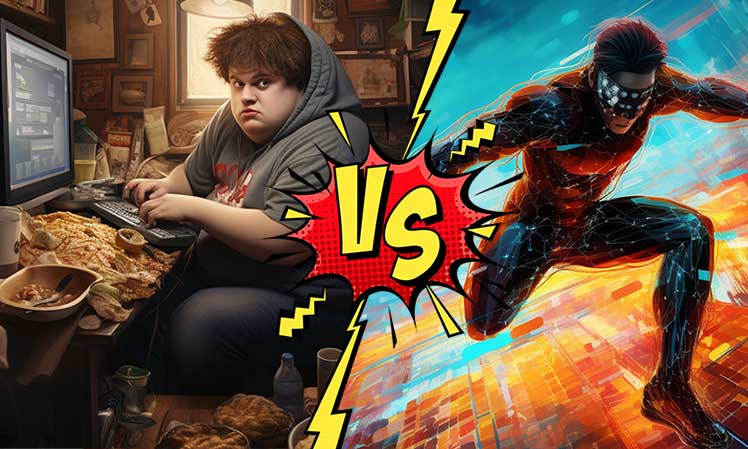
To give their players an edge, many top esports teams endorse regular exercise, sound nutrition, and stable sleep patterns for their players. Clinical studies(1) validate this approach: regular exercise reduces physical pain and depression — while boosting quality of life.

Despite this, around 34.5 million Americans suffer from chronic musculoskeletal pain (MSK) — while obesity runs rampant. Statistics suggest that these trends are largely tech-driven:

As computing times increased over the years, sedentary times, obesity levels, and musculoskeletal issues have skyrocketed. These problems obliterate the executive functioning powers of the brain.
But in the emerging IoT era, a sharp brain will be essential to process data from all facets of life. Some will succeed; others will become ‘useless’ burdens on society:
Internet Of Things (IoT) Technostress
Alvin Toffler first predicted a major shift from an industrial to information society. AOL founder Steve Case followed up by pointing out the Internet’s evolutionary objective.
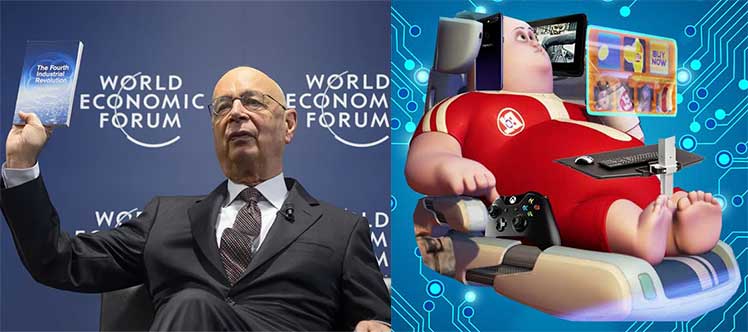
WEF Chair Klaus seizes on that objective by hyping an impending 4th Industrial Revolution, aka the Internet of Things (IoT).
To keep up, professionals must find ways to ward off physical and mental technostress. That will require sharp executive functioning brain ability — which is dependent on physical health.
Toffler’s Third Wave
Alvin Toffler’s Third Wave book(2) described three major waves of socio-technological change:
- First wave: a transition from hunter-gathering to agriculture.
- Second wave: an industrial age centered around a nuclear family.
- Third wave: a transition into the Information Age. Then, knowledge will become more valuable than material items.
In his preceding book Future Shock, Toffler predicted that rapid social and economic upheaval would place immense pressure on traditional life. Then, nuclear families would become unsustainable.

Replacing nuclear families would be blended ones. A nuclear family consists of a married couple and their children.
In contrast, a typical blended family includes at least one step-parent, step-siblings, and/or half-siblings. An IoT blended family would go a collective step broader.
Blended Family IoT Neighborhoods
Toffler predicted that Third Wave prosumer societies would favor individuation over mass consumption. The social nexus would become family first and neighborhood second.

That opens the door for local, prosumer educators to assume a place within blended family concepts. Their role will be to guide youth as they perform tasks or consume data. That frees IoT parents to go harder at work.
Active Prosumers Vs Passive Consumers
Those who thrive in this era will be the ones best able to embrace disruption and go with the flow. Toffler calls these people ‘prosumers’.
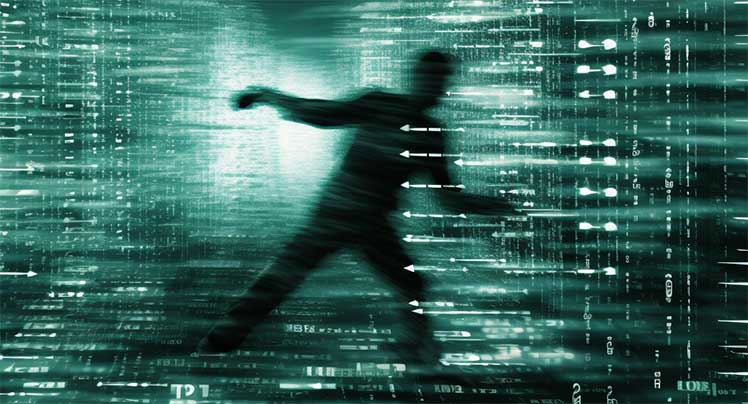
Technology will give them the means to produce their own goods and services for sale. In fact, prosumer culture is unfolding right now all around us.

Twitter is teeming with citizen journalists. Many earn a living selling handicrafts on Etsy. Fiverr lets people sell digital services. Gumroad lets creators sell courses and digital products.
These creators rely on consumers to buy their wares or take in their content. But in the IoT era, a pure ‘consumer’ means someone unable to contribute.
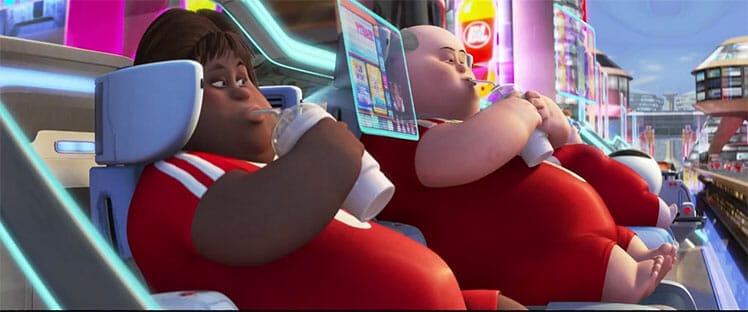
Those folks will fall to a lower class of society. They’ll bring nothing to the collective table other than a consumption of resources.
Steve Case’s Third Wave
In 2017, AOL co-founder Steve Case released his own Third Wave book(3). It built upon Toffler’s work by pointing out the ultimate direction the internet is headed.

Case described its evolution with three major waves:
- First wave: 1990s launch of the World Wide Web.
- Second wave: rise of tech giants (Google, Amazon, Facebook) connected by mobile devices.
- Third Wave: an Internet of Things (IoT) that connects to cars, homes, cities, and nature.
Schwab’s 4th Industrial Revolution
The World Economic Forum hypes what’s coming as the 4th Industrial Revolution. Its aim: wrap the entire planet into a full-blown Internet of Things (IoT).

WEF Chair Klaus Schwab’s 4th Industrial Revolution book(4) cites tech breakthroughs that make this possible. These include artificial intelligence, robotics, autonomous vehicles, biotechnology, and quantum computing.
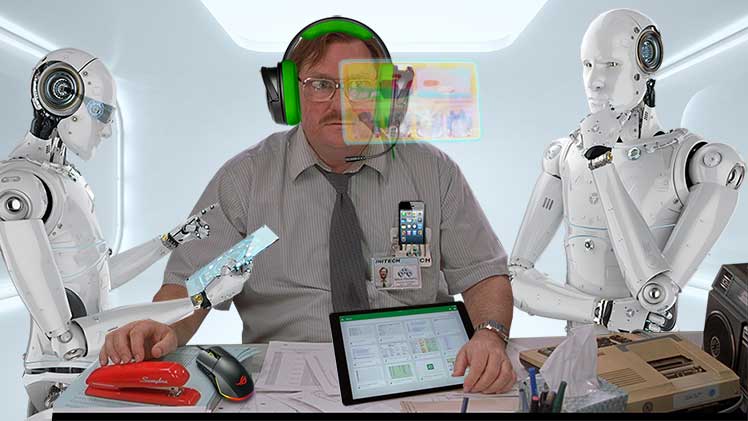
This will result in “billions of people connected by mobile devices, with unprecedented processing power, storage capacity, and access to knowledge.”
The Technostress Conundrum
Schwab’s vision aims to wrap the world in a perpetual state of near-virtual reality. But there’s a problem: humans are not equipped to be plugged into machines non-stop.

Doing so yields three types of technostress that institutional ergonomists are scrambling to solve:
- Physical technostress: extended use of laptops and mobile devices increases the risks for musculoskeletal disorders.
- Mental technostress: cognitive overload comes from using too many complicated gadgets at once.
- Techno-addiction: inability to disconnect. Techno-addicts hooked on dopamine hits will compulsively use their phones to combat boredom.
Executive Function Digital Overload Danger
At the heart of the technostress issue there are biological brain limits. The brain works like a muscle. When depleted of energy, it becomes less effective.

Executive function is a self-regulation mental process that emanates from the prefrontal cortex part of the brain. It lets us execute plans, focus attention, and multi-task.
When focusing on a task for extended periods, executive function keeps you locked in. It also powers disciplinary actions like eating healthy food instead of cake.
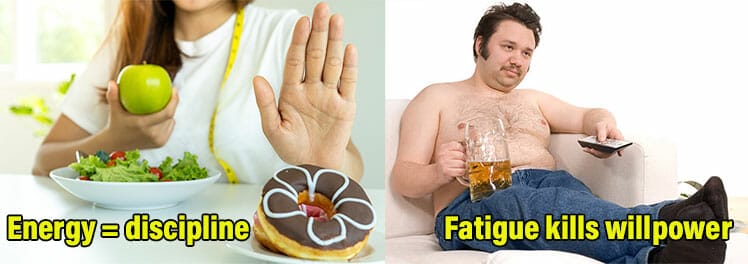
In fact, any process needing conscious effort (like resisting food temptations) depends on executive function. However, this is a single brain resource with a limited capacity(5).

If your brain is always fried, you’ll struggle with other tasks that need discipline — like keeping your desk clean. Studies show that working in clutter has a negative impact on cognition, mood, emotions, and behavior.
As clutter jacks stress levels, people turn to coping mechanisms. Common ones include overeating, binge drinking video games, and social media.
Executive Function Problems Among Young Gamers
The brain’s prefrontal cortex is the executive function command center. This part of the brain doesn’t develop until the age of 25. A few hours of intense gaming can exhaust executive functions.

That explains why young gamers often neglect basic needs like food, sleep, exercise and personal hygiene. When their executive functioning limits get fried, they lack the resources for focus or discipline(6).
As a reference, here are the average attention spans of different ages:
- 4 years old: 8 minutes
- 8 years old: 16 minutes
- 12 years old: 24 minutes

After 16 minutes of focus on a basic task, an 8-year-old will have exhausted their executive functioning ability. Without time to recharge, energy for other tasks will vanish. Then slothful habits, gluttony, and apathy may take over.
Navigating Executive Functioning: Cognitive Limits In The Internet Era
Per Openvault’s 2022 Q4 Internet Report(7), the average monthly data used by subscribers was 586.7 GB (19.5 GB per day). The amount of ‘power users’ consuming over 1TB per month rose 16% over the previous year.

With impending smart city infrastructure and IoT devices, this figure will skyrocket. Smart sensors, autonomous cars, and home appliances will all spew data. Keeping on top of it all will push executive function to extreme endurance levels.
Unhealthy Computing Statistics
In the current era, billions are already struggling. This section outlines running rampant in the Second (pre-IoT) iteration of the Internet:
- Increased sedentary time
- Obesity: as people move less and eat more, they get fatter.
- Brain Fog: sedentary, overweight people have a smaller mental capacity than the physically fit.
- Physical breakdown: sedentary, obese, internet addicts suffer physical problems that amplify their inability to focus.
Increased Sedentary Time
The percent of the labor force in high-activity occupations was a steady 30% from 1950 to 1970. Over the next 30 years, high-activity jobs declined to reach 22.6% in 2000(8).
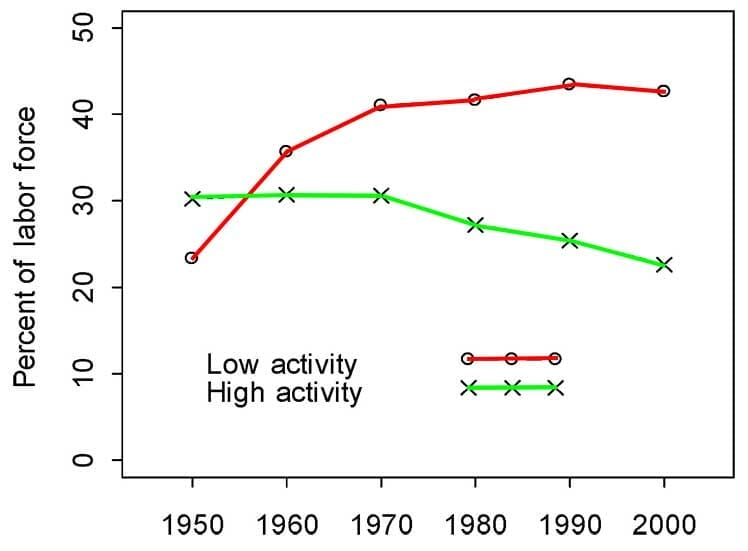
In 1950, around 30% more Americans worked in high-activity occupations. By 2000, there were twice as many people in low-activity jobs versus high-activity ones. In 2012, University of North Carolina researchers dove deeper.
They looked at MET versus sedentary statistics collected since 1965. Then, they projected those to 2030(9).
The Metabolic Equivalent of Task (MET) is an exercise testing measurement. One MET = an oxygen consumption rate of 3.5 ml per kg of body weight per minute. If an activity has a MET value of 2, you burn twice the calories than when at rest.
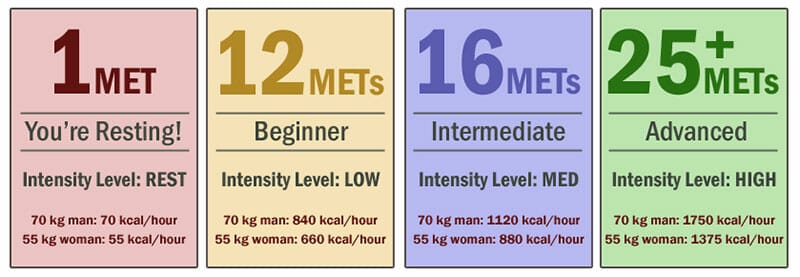
To calculate MET hours, you multiply the MET value of an activity by its duration in hours. So an activity with a MET value of 2 done for 2 hours = 4 MET hours.
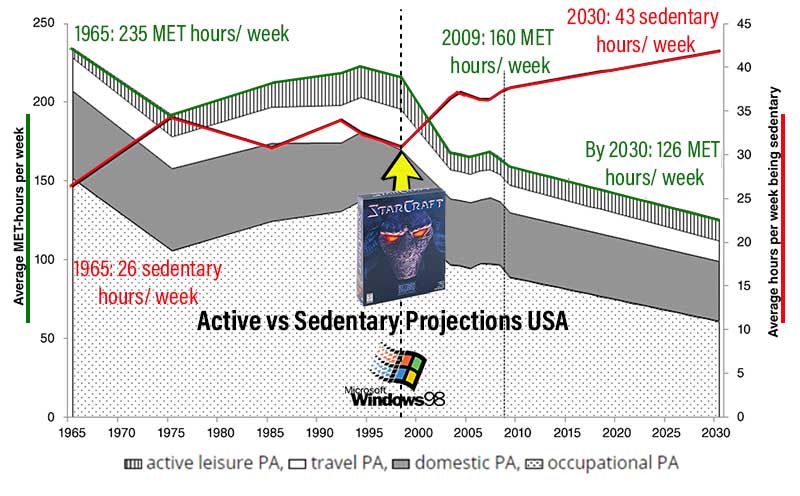
The researchers noted that 1965’s 235 MET-hours expended per week was ‘somewhat low’. By 2023, it’s forecast to reach a dangerously low 126 MET-hours per week.
Video Games And Sedentary Lifestyles
The MET-hours graph shows a sharp spike upwards in 1998 (the Windows 98 era) — aka one of the best years in video game history(10).
That year saw the release of the Unreal engine. It brought 3D technology to a higher level. Then, Half-Life showed off the narrative potential of first-person shooters. The same year, StarCraft debuted.

Its release went red-hot in South Korea, playing a pivotal role in the formation of the competitive gaming scene.
Birth Of Esports: Starcraft + South Korea 1998
Active Vs Sedentary Levels Through Time
Meanwhile, time spent engaged in sedentary behavior (1 MET) averaged just 26 hours per week in 1965. By 2030, that is expected to reach 43 sedentary hours per week — sloth-like levels.
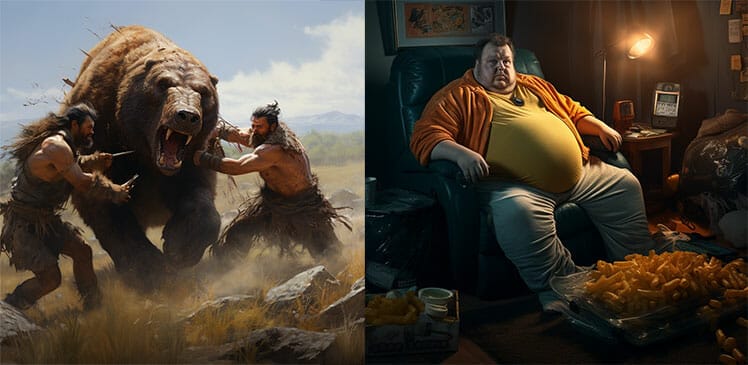
These activity levels burn around 65% less energy per day than the average Paleolithic hunter-gatherer. To reach those activity levels, a 70 kg modern adult would need to walk 19 km (12 miles) per day.
During the Colonial period (1700-1776), Americans plowed, hunted, and herded their way to high levels of fitness. Post-Civil War (1865-1900), industrial life replaced the old agricultural one. Then, the masses transitioned to sedentary city living(11).

That was around the same time that mandatory schooling kicked in nationwide. Then, a generation of once-feral farm kids transitioned to a sedentary life of full-time desk work.

Kids were suddenly forced to sit ramrod straight all day long on rigid wooden seats. Those who fidgeted or failed to comply were violently assaulted into obedience. Learn more:
Obesity Epidemic
Modern, sedentary humans burn less energy per day than their pre-industrial ancestors. But they also consume more. In fact, the American diet began to radically change in the mid-1800s(12).

Technological advances, urbanization, and the rise of food conglomerates were all factors. Foods became progressively more processed. This was associated with a parallel but delayed rise in non-communicable diseases (NCDs).
Chronic NCDs include abdominal obesity, type 2 diabetes, gout, heart disease, strokes, cancer, and Alzheimer’s disease.
Rising Obesity In The Computing Era
The emergence of personal computing in the 1990s coincided with skyrocketing childhood obesity. For instance, this CDC chart shows sharp upward obesity trends for ages 6-11 and 12-19 (prime video gaming age):

Another study found that sedentary behaviors rise as children get older(13). It measured activity levels of various age groups over an 8-year span.
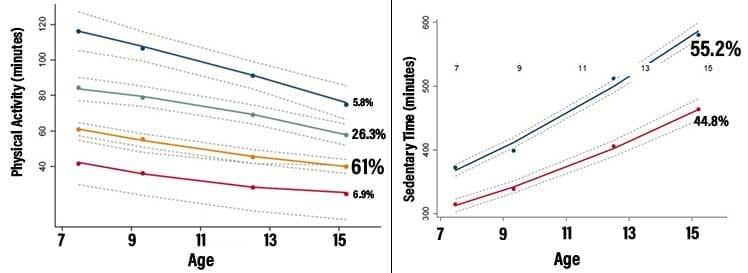
Significantly, the number of overweight adolescents has tripled since 1980; the prevalence among younger kids has more than doubled(14). Beyond sedentary behavior, contributing factors included:
- More fast food: energy intake from away-from-home food sources increased from 20% to 32%.
- Missed breakfasts: more missed breakfasts — especially for children of working mothers.
- Less milk: in 1977-78, children aged 6-11 drank four times as much milk than any other beverage. By 1996, they consumed twice as many sugar-sweetened drinks than milk.
- More soda: soda consumption spiked in the mid-1990s. Soft drink consumption for adolescent boys almost tripled between 1977-1994.
Obesity Brain Fog Epidemic
Obesity causes functional and structural changes in the brain. For example, high body fat reduces brain grey matter volume. Grey matter contains neurons that process and transmit information.
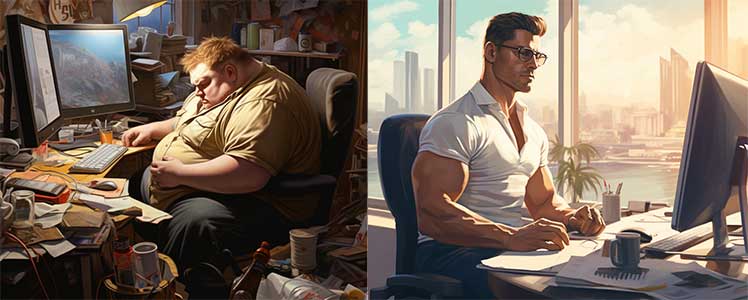
So as a person gets fatter, their cognitive functioning slows(15) in many ways:
- Conditions associated with obesity (like hypertension & inflammation) cause metabolic and circulatory brain dysfunctions.
- Obesity is linked with reduced cognitive functioning, short-term memory loss and learning difficulties.
- Obese people have less cognitive flexibility (the ability to alter plans on-the-fly).
Behavioral patterns have also been identified in obese individuals. These include a lack of initiative, inhibition, and self-monitoring. Typically, these traits are expressed as apathy, impulsivity, and poor behavioral control.
Obesity Physical Breakdown Epidemic
Overeating while living a sedentary life will fatten your belly and fog up your brain. Once in that abyss, the body breaks down. That makes losing weight a monumental task.

These physical issues are common in the obese:
- Weak spines and knees: those with a BMI (body mass index) over 35.0 are 63.1% weaker in lower joint strength than slimmer types.
- Tender feet: toting more weight degrades shock-absorbing elasticity in the feet. This affects posture and mobility.
- Destroyed knees: adults 18-29 with a BMI over 35 are 80% more likely to suffer knee problems later in life.
- Greater musculoskeletal burdens: musculoskeletal pain is 26% higher among obese kids. The link between obesity and musculoskeletal pain have been found in children as young as 2.
Existing Deskwork Essentials
These days, Americans spend around 55% of their waking time (7.7 hours a day) engaged in sedentary behaviors. In South Korea (the spiritual center of pro esports) 20.6% of adults are sedentary for 12+ hours per day.

But the human body is not designed to sit for long periods. Doing so misaligns the spine. That places severe strain on back muscles to hold the spine upright.
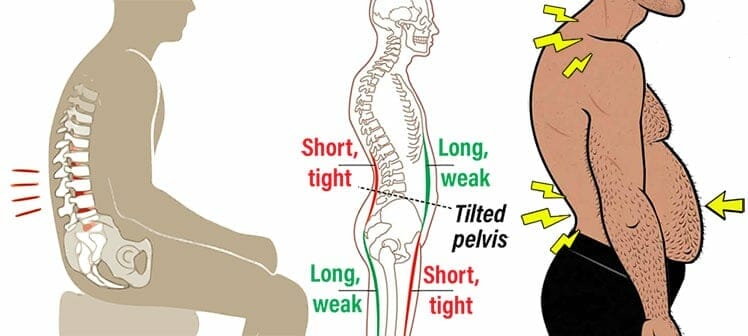
Over time, that can result in serious spinal deformities. For example, it’s estimated that around 80% of U.S. adults suffer from anterior pelvic tilt. This is unnecessary: solutions for tech-related spinal misalignments already exist.
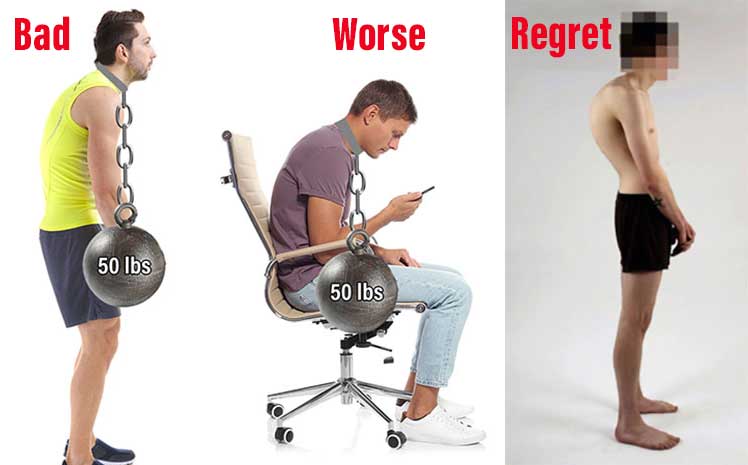
There are three fundamentals. The third is the most crucial:
- Ergonomic seating: supports the spine into a healthy standing alignment for long periods.
- Sit-to-stand desk: supports multi-device (PC and mobile) computing + movement.
- Healthy lifestyles: fitness + nutrition + quality sleep enhances executive functioning in the prefrontal cortex.
Ergonomic Chair: Dynamic Neutral Support
The science of healthy sitting was all guesswork until 1973. Then, NASA scientists studied astronauts in zero gravity. When working or relaxed, they naturally fell into neutral body postures (NBP).
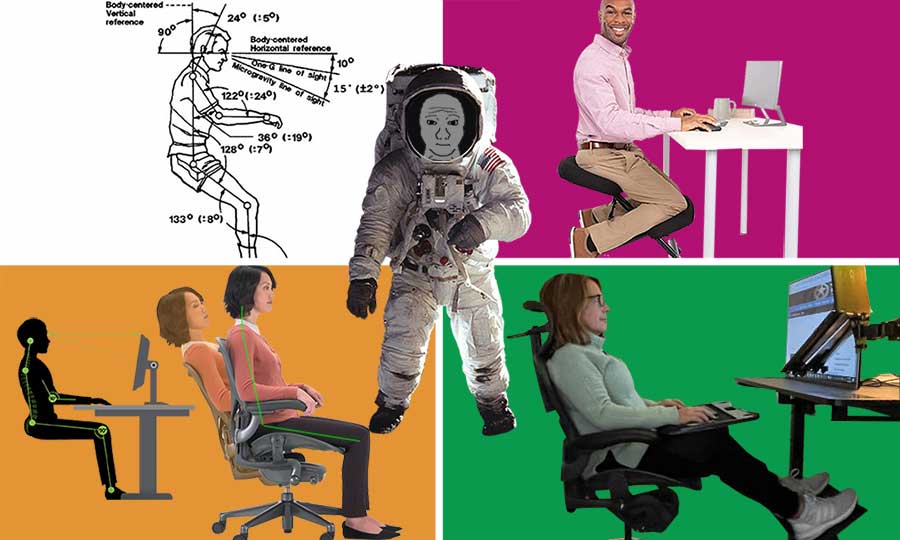
NBP is the foundation of all modern-day ergonomic seating options. There are many variations. But in all cases, the point is to align the spine into a healthy neutral posture.
The institutional definition of ‘ergonomic’ seating is straightforward. All types of ergonomic chairs power neutral postures with a trio of components:
Adjustable lumbar support aligns the spine. Adjustable arms add more bracing to prop your torso up against gravity. A reclining backrest lets you customize support angles and stimulate movement.
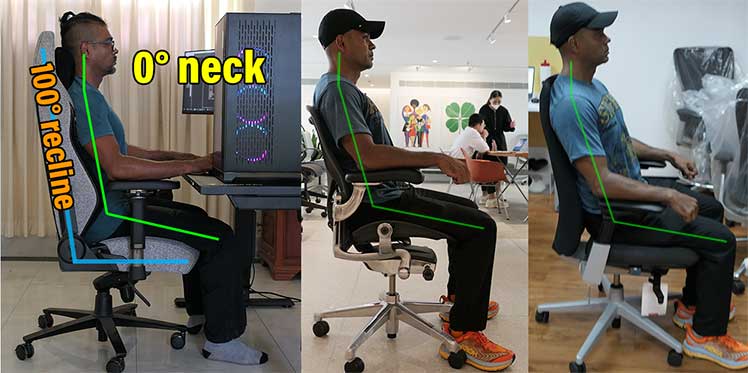
There are myriad benefits gained by sitting with good posture. The most significant is zero pain while sitting. Without pain, sitting for long periods is a pleasure.
The next big one is a huge surge of energy. Instead of muscles doing the work, your chair does. Other benefits of good sitting posture include:
- Fewer headaches: good posture reduces the neck tension that causes migraines.
- Reduced joint stress: awkward sitting misaligns the hips, placing stress on the joints.
- More oxygen: good sitting posture opens the chest, increasing oxygen intake.
- More energy and focus: an aligned body works muscles efficiently, leaving more power for brainwork.
- Improved digestion: efficient bodily operation speeds metabolism and waste passage.
Gaming Chair Benefits For Men, WOmen & Kids
Ergonomic Seating Limitations
Ergonomic seating comes with two significant downsides. First, despite the hype, none of the chairs on the market adequately support movement(16). Fancy tilt functions have a toy-like impact.
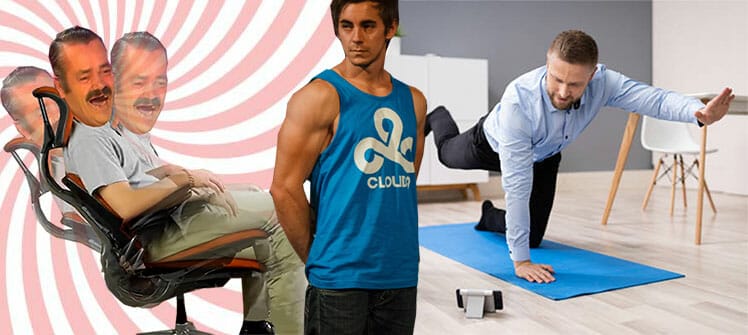
The second big downside has to do with executive functioning. Sitting with neutral postures — and maintaining them — takes awareness and effort. Without that effort, the chair won’t help.
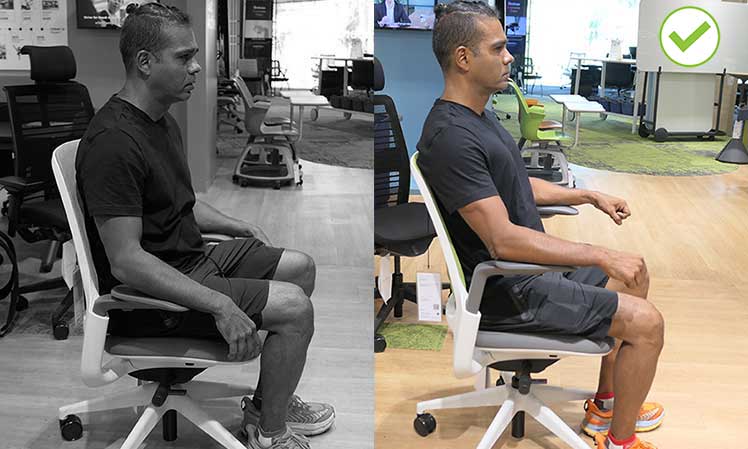
Some people make the mistake of relying wholly on the chair. Check r/OfficeChairs on Reddit to see a staggering number of people buying multiple $1000+ chairs. They are looking for ‘magic’ that doesn’t exist!

Without effort put into neutral-ish postures, the type of chair you use does not matter. In any type of gaming or office chair, sloppy usage will yield poor posture and back pain.
Neutral Sitting Posture Fundamentals
Related: How To Sit With Neutral Posture in ANY Type Of Ergonomic Chair
Standing Desk: Movement + Mobile Support
Sit-to-stand desks pick up the movement slack left behind by ergonomic chairs. These let you shift from sitting to standing at the push of a button.
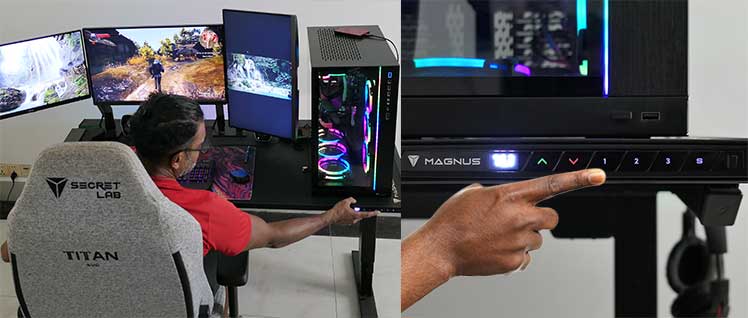
Shifting from sitting to standing (or vice versa) replicates a squat. That works legs, hip, and back muscles while giving your circulation a good boost.
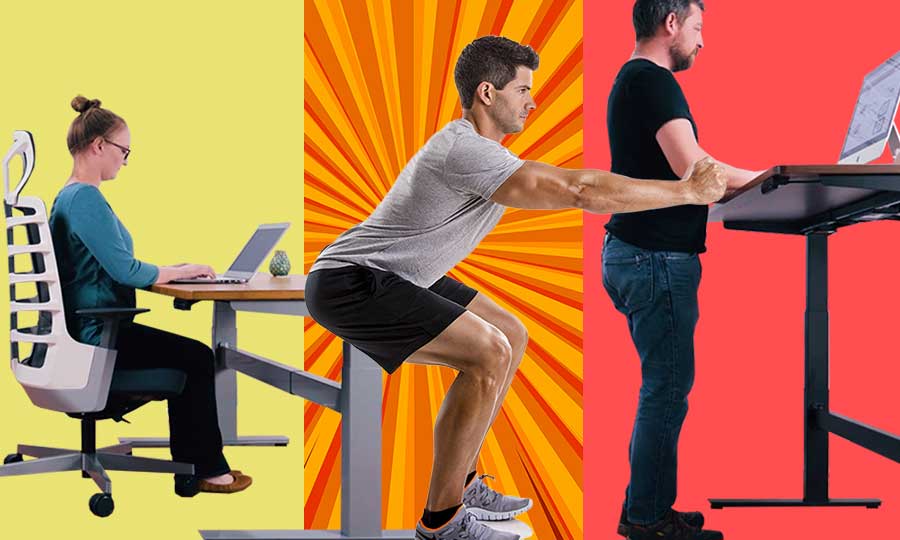
On top of that, it’s easier to maintain good posture while standing — almost effortless for a few hours at a time.

However, text neck syndrome is running rampant in our current mobile era. To that end, standing desks also support multi-device (PC & mobile) computing.
Sit-To-Stand Desk Pros & Cons: Worth It?
Standing Desk Limitations
Experts suggest aiming for a 1:1 ratio while using a sit-stand desk. So if you stand for an hour, you should then sit for an hour.
Many studies have identified mental barriers that dissuade using the sit-to-stand functions. These are habitual: people are so used to sitting that they ‘forget’ to stand. Key issues:
- Inconsistent use: the most common barrier to a smooth integration into dynamic workstations.
- Training is necessary: a study among 4 Swedish companies found that only 20% of staff make regular sit-stand transitions without training. As a result, they gain zero musculoskeletal benefits.
- Training wears off: even with training, use of the sit-to-stand functions tends to decrease over time.
This explains the emergence of technologies like the Movably Smart chair. It supports frequent sit-to-stand transitions with built-in sensors which vibrate at intervals.
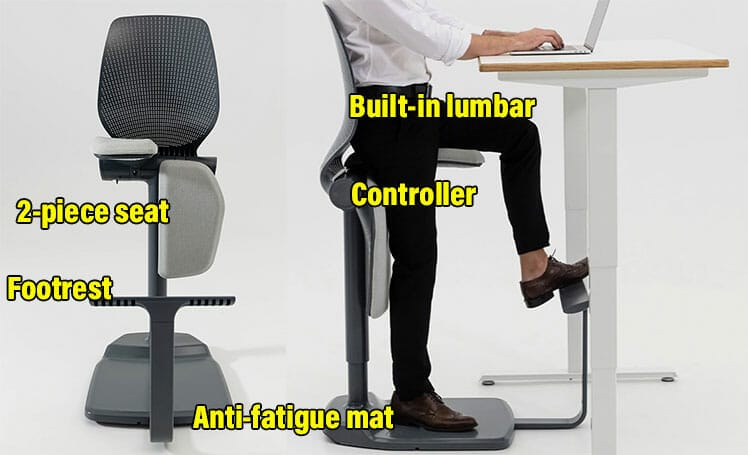
It also has a two-sides seat. That supercharges movement by letting you stand, put one foot up, or shift to a full sitting mode in seconds. Learn more:
Health Triad: Exercise + Nutrition + Sleep
Many top esports teams provide their players with high-end computers, desks, and ergonomic chairs. They also coax their players towards a health-oriented approach. The idea is that healthy, rested players perform to higher levels.
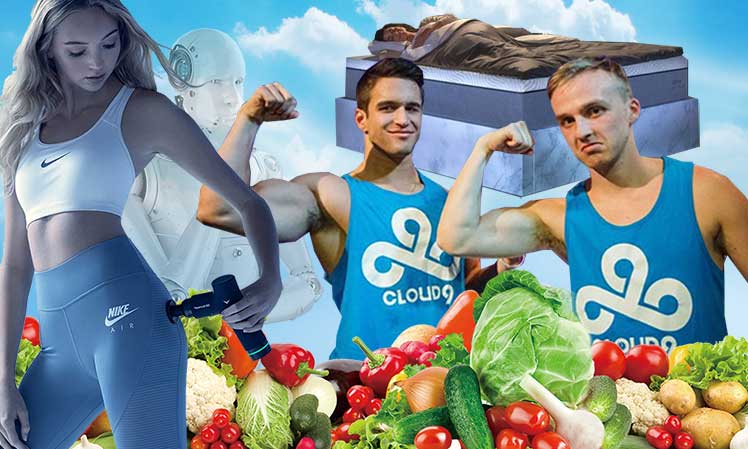
Clinical reviews support this approach for all desk workers(1). A fit, healthy lifestyle reduces physical pain and depression — while boosting one’s quality of life.
Recap: IoT Active Lifestyle Shift
This article predicts that the IoT Era will force people to adopt healthy lifestyles – or get left behind.
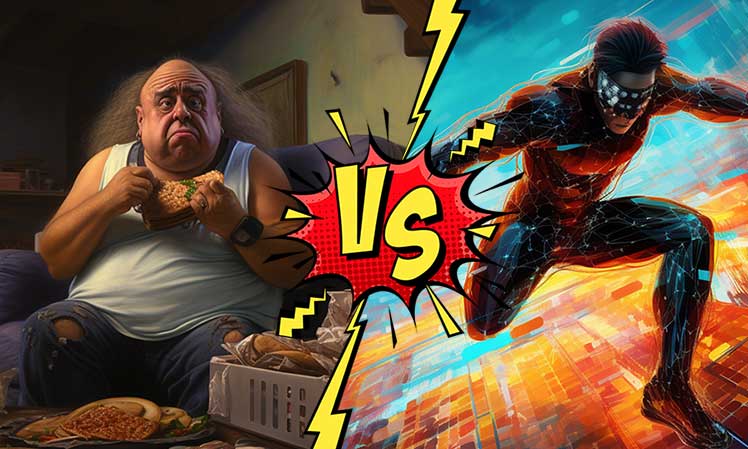
Here’s a summary of the key problem:
- 4th Industrial Revolution: the Internet of Things (IoT) will yield hyper-connected hubs of prosumer production. Pure consumers making no contributions will fall to a lower class.
- More data to process: in 2022, the average person consumed around 19 GB per day. In the hyper-connected IoT era, they may consume 100x more.
- Executive function overload: the brain is not equipped to take in large amounts of data without time to rest. Once burned out, willpower, discipline, and focus crumble.
- Sedentary obesity: brains fried on tech fall into sloth, poor hygiene, and junk food gluttony. That creates a downward spiral: physical and mental breakdown.
Ergonomic seating and a sit-to-stand desk are handy health aids in the tech era. These help you manage your physical & mental health while computing.
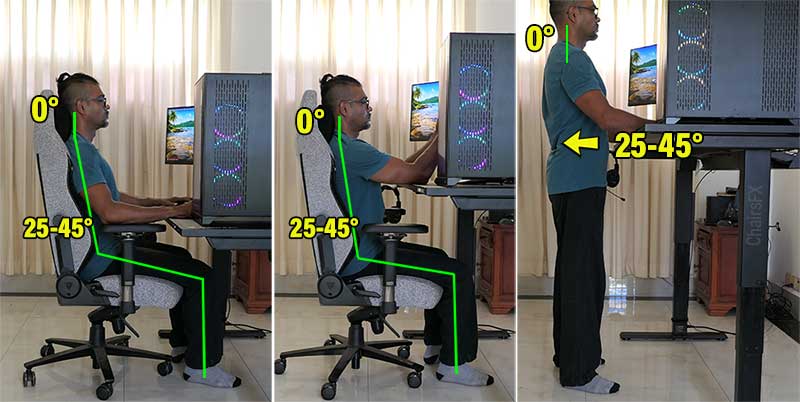
Steelcase recently looked into this by asking ‘What Does Gen Z Want?’ From potential employer, Gen Z want two things above all else: a good work-life balance and their own dedicated ergonomic chair + desk + computer setup.

From a long-term, IoT perspective, that also works. A good ergonomic setup + enough time to recharge between sessions gives workers the flexibility they need to thrive.
Physical Fitness Trumps All
Beyond a good setup + downtime, fitness stands out as the big difference-maker among Gen X, Millennial, and Gen Z age groups. Among each, the majority are sliding into inertia and obesity.
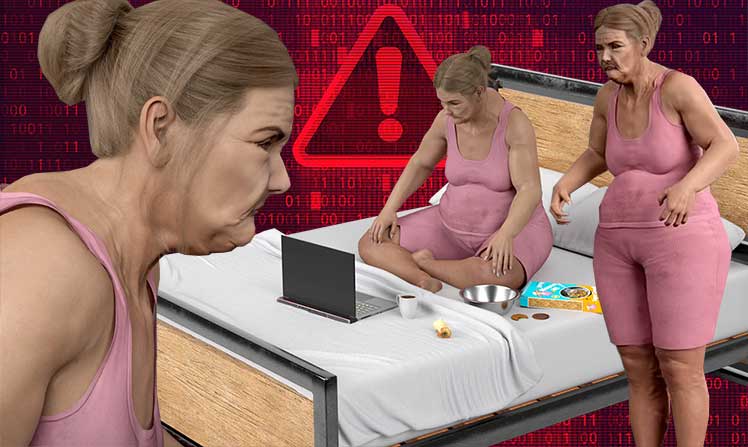
A smaller, savvier percentage in each group swings the esports way: good setups + healthy lifestyles = peak performance.
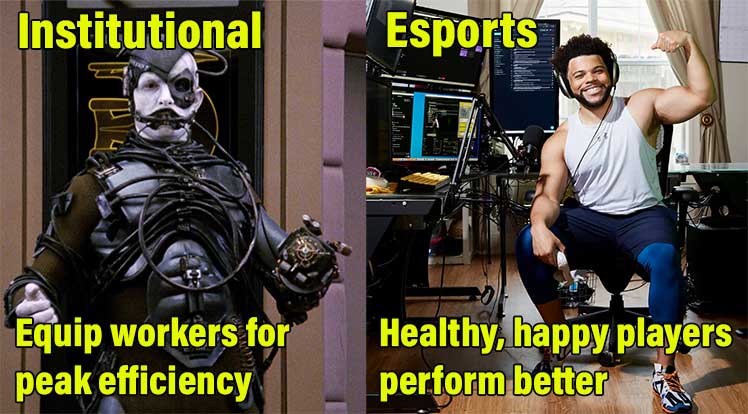
In the emerging IoT era, these fit, muscular aces will jostle for dominance. Meanwhile, fat, unhealthy consumers are at risk of becoming ‘unemployable’. Without good posture and fitness, they’ll lack the energy to power a brain that keeps up.

This is why the IoT era will likely spark a major sedentary to active lifestyle shift. To keep up with the times, aspiring professionals won’t have a choice. Learn more from Gen X, Millennial, and Gen Z perspectives:
Footnotes
- Grace Wang et al. ‘Older Adult Use and Outcomes in a Digital Musculoskeletal (MSK) Program, by Generation’. August 3, 2021, doi: 10.3389/fdgth.2021.693170, (accessed 29 June, 2023).
- Alvin Toffler. ‘The Third Wave’. William Morrow, 1980. Printed Material. Read an online PDF version, (accessed 4 July, 2023).
- Steve Case. ‘The Third Wave’. Simon & Schuster, April 18, 2017, https://www.simonandschuster.com/books/The-Third-Wave/Steve-Case/9781501132599, (accessed 4 July, 2023).
- Klaus Schwab. ‘The Fourth Industrial Revolution’. Penguin Books Limited, 2016. Read an online PDF version, (accessed 4 July, 2023).
- On Amir. ‘Tough Choices: How Making Decisions Tires Your Brain’. Scientific American, July 22, 2008, https://www.scientificamerican.com/article/tough-choices-how-making/, (accessed 4 July, 2023).
- Cam Adair. ‘How Gaming Affects the Brain’. September 18, 2022, https://gamequitters.com/how-gaming-affects-the-brain/, (accessed 4 July, 2023).
- Openvault. ‘Broadband Insights Report (OVBI) 4Q22’. Q4, 2022, https://openvault.com/wpcontent/uploads/2023/02/OVBI_4Q22_Report.pdf/, (accessed 4 July, 2023).
- Ross C. Brownson, et al. ‘Declining Rates Of Physical Activity In The United States’. Annual Review of Public Health, Vol. 26:421-443 (Volume publication date 21 April 2005). https://www.annualreviews.org/doi/10.1146/annurev.publhealth.26.021304.144437, (accessed 4 July, 2023).
- S. W. Ng, et al. ‘Time use and physical activity: a shift away from movement across the globe’. Wiley Online Library, 14 June, 2012. https://onlinelibrary.wiley.com/doi/full/10.1111/j.1467-789X.2011.00982.x (accessed 4 July, 2023).
- Daniel Hindes. ‘Why 1998 Was the Best Year in Gaming’. December 28, 2014, https://www.gamespot.com/articles/why-1998-was-the-best-year-in-gaming/1100-6424354/, (accessed 4 July, 2023).
- Lance C. Dalleck, M.S. and Len Kravitz, Ph.D. ‘The History of Fitness’ University of New Mexico, https://www.unm.edu/~lkravitz/Article%20folder/history.html, (accessed 4 July, 2023).
- Joyce H. Lee, et al. ‘United States Dietary Trends Since 1800: Lack of Association Between Saturated Fatty Acid Consumption and Non-communicable Diseases’ Front Nutr. 2021; 8: 748847. Published online 2022 Jan 13, https://www.ncbi.nlm.nih.gov/pmc/articles/PMC8805510/, (accessed 4 July, 2023).
- Cheryl D. Fryar, et al., ‘Prevalence of Overweight, Obesity, and Severe Obesity Among Children and Adolescents Aged 2–19 Years: United States, 1963–1965 Through 2017–2018’. CDC, Division of Health and Nutrition Examination Surveys. 2021 Jan 29, https://www.cdc.gov/nchs/data/hestat/obesity-child-17-18/obesity-child.htm, (accessed 4 July, 2023).
- Jennifer Bishop, et al., ‘Childhood Obesity’. ASPE Childhood Obesity White Paper, Apr 30, 2005. https://aspe.hhs.gov/reports/aspe-childhood-obesity-white-paper, (accessed 4 July, 2023).
- Erick Gómez-Apo, et al. ‘Structural Brain Changes Associated with Overweight and Obesity’. J Obes. July 16, 2021, https://www.ncbi.nlm.nih.gov/pmc/articles/PMC8302366/, (accessed 4 July, 2023).
- Jennifer Pynt. ‘Rethinking design parameters in the search for optimal dynamic seating’. J Bodyw Mov Ther. 2015 Apr;19(2):291-303. https://pubmed.ncbi.nlm.nih.gov/25892386/, (accessed 4 July, 2023).




